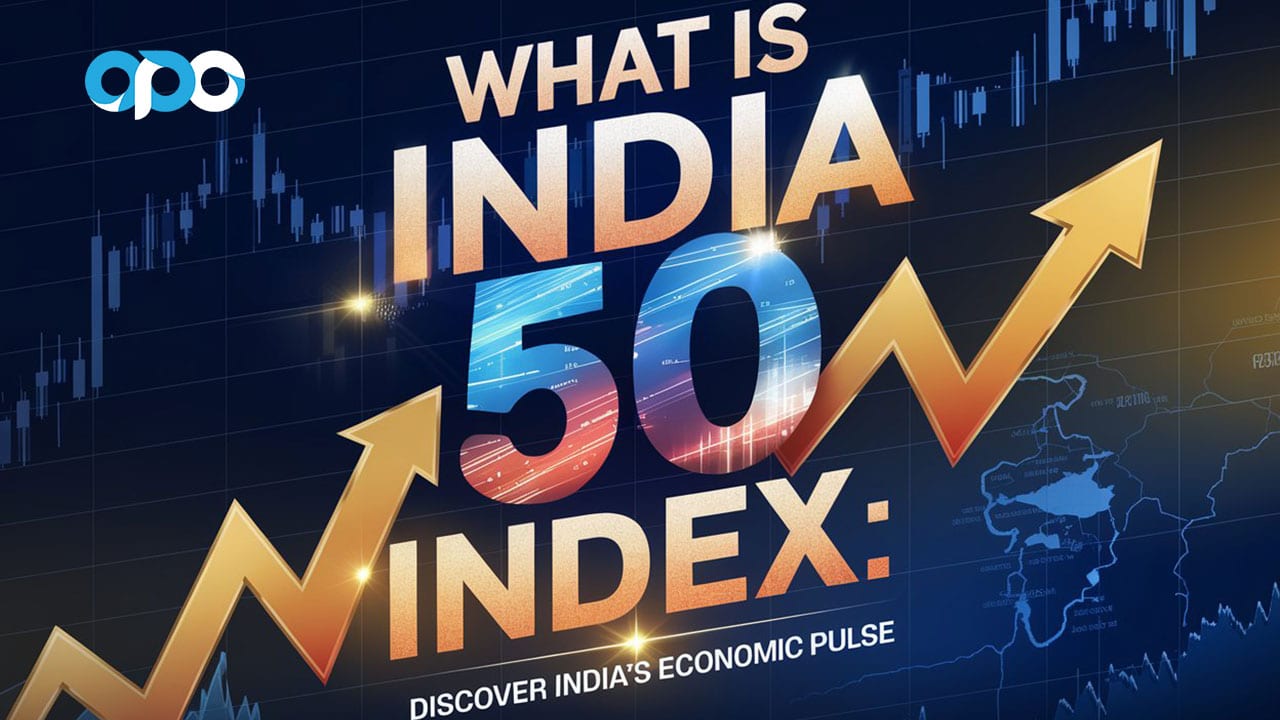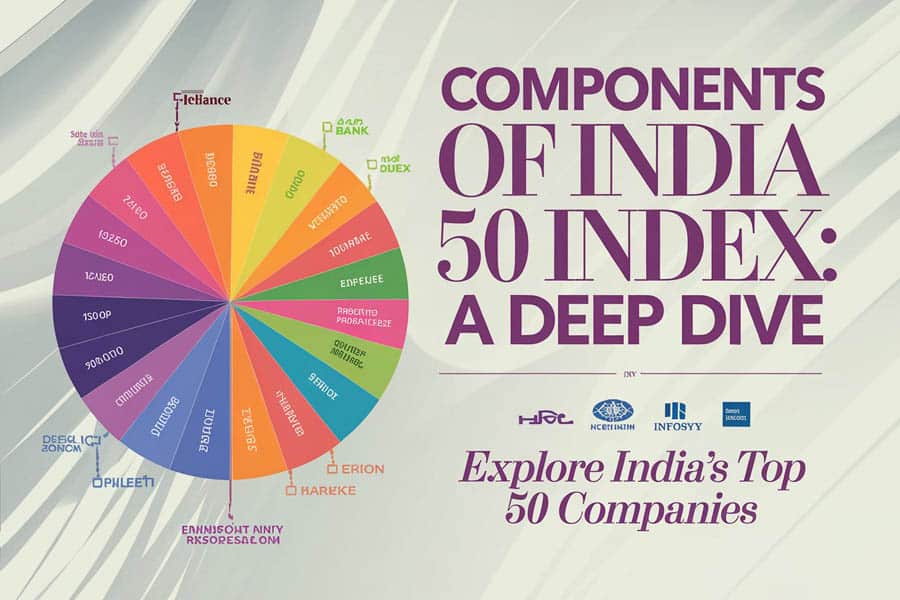Ever felt the urge to truly understand the pulse of the Indian stock market? The India 50 Index, globally recognized as the NIFTY 50, isn’t just a collection of ticker symbols; it’s the very heartbeat of India’s economic engine. Think of it as the ultimate yardstick, meticulously measuring the performance of the 50 largest and most actively traded companies listed on the National Stock Exchange of India (NSE). This isn’t just about numbers; it’s about understanding the trajectory of the Indian economy itself.

This comprehensive article will serve as your definitive guide, offering an India 50 Index explained breakdown, clarifying the India 50 Index meaning, dissecting the crucial India 50 Index components, and revealing how you can potentially leverage its insights, even through avenues like a reliable online forex broker. Whether you’re a seasoned investor or just starting your trading journey, the India 50 Index offers a gateway to understanding India’s economic growth and market potential.
Get ready to embark on a detailed exploration of this pivotal financial instrument and discover the wealth of information it holds for astute investors and traders worldwide.
Introduction to India 50 Index: The Definitive Market Barometer

The India 50 Index is far more than a simple list of companies; it’s a strategically constructed portfolio designed to mirror the breadth and depth of the Indian economy. Its core definition and unwavering purpose revolve around providing a robust benchmark against which the performance of other Indian equity mutual funds, exchange-traded funds (ETFs), and individual investment portfolios can be rigorously evaluated. Imagine a doctor trying to assess a patient’s overall health without checking their key vital signs – it’s simply incomplete. Similarly, the India 50 acts as that essential vital sign for the Indian stock market. It furnishes investors, analysts, and economists with a clear, concise, and easily understandable overview of how the largest, most influential, and most liquid companies are performing, thereby effectively encapsulating the prevailing sentiment and direction of the broader market. A genuine understanding of this index is not merely beneficial; it’s absolutely paramount for anyone seeking to engage with the dynamic Indian financial landscape. Choosing the right broker for forex trading can even allow you to gain exposure to this index through different financial instruments.
History and Development of the India 50 Index: Tracing Its Evolution
The journey of the India 50 Index began on April 21, 1996, a landmark date etched in the history of the National Stock Exchange of India. Since its inception, the index has been a silent observer and, in many ways, a reflection of the remarkable and often rapid transformation of the Indian economy. Its launch was a pivotal moment, finally providing the Indian financial markets with a standardized, transparent, and widely accepted benchmark for performance measurement. Over the ensuing years, the index has navigated numerous economic cycles and witnessed significant milestones that have shaped its current form. A key evolutionary step was the adoption of the free-float market capitalization weighting methodology. This crucial shift ensured that the index more accurately represents the portion of the market that is readily available for investment, excluding strategically held shares. This commitment to evolution underscores the index’s enduring relevance and its unwavering reliability as a primary indicator of India’s ever-growing economic might.
Read More: Analysis of International Markets in Forex
How the India 50 Index is Calculated: Decoding the Underlying Mechanics

The meticulous calculation of the India 50 Index hinges on the principle of the free-float market capitalization method. This sophisticated approach meticulously considers the aggregate market value of a company’s outstanding shares that are readily available for public trading. In essence, this method intentionally excludes shares that are locked-in or held by promoters, government entities, and other strategic long-term investors, thus providing a much more precise and accurate representation of the actual investable market capitalization. The index’s historical baseline is anchored to November 3, 1995, which serves as the base date, with an assigned base value of 1000. The index value at any given moment in time is determined by a specific formula:
Index Value = (Current Aggregate Free-Float Market Capitalization / Index Divisor) * Base Index Value
- Current Aggregate Free-Float Market Capitalization: This represents the sum of the market capitalization of all 50 constituent companies, considering only the shares available for public trading. The market capitalization of each company is calculated by multiplying its current share price by the number of its outstanding free-float shares.
- Index Divisor: This is a crucial adjustment factor that ensures the continuity of the index’s value despite corporate actions such as stock splits, rights issues, and mergers. The divisor is adjusted to neutralize the impact of these corporate events, preventing them from artificially inflating or deflating the index value. It ensures a like-for-like comparison over time.
- Base Index Value: As mentioned earlier, this is the initial value of the index set at 1000 on the base date.
This robust and carefully designed methodology guarantees that the index remains a consistently precise and dependable measure of overall market performance, irrespective of corporate restructuring activities.
Components of the India 50 Index

The India 50 Index components are not static; they represent a carefully selected and dynamically maintained reflection of the diverse sectors that collectively power the Indian economy. As of the most recent periodic review and adjustments, the top-tier companies within the index typically include well-established industry leaders spanning critical sectors such as:
- Financial Services: Powerhouses like HDFC Bank (approx. 9-10% weightage), ICICI Bank (approx. 7-8% weightage), and State Bank of India (SBI) play a pivotal role. Traders often monitor these stocks for cues on the overall financial health and lending activity in the economy.
- Information Technology (IT): Global IT giants such as Infosys (approx. 6-7% weightage) and Tata Consultancy Services (TCS) (approx. 6-7% weightage) hold significant sway. Their performance is closely linked to global technology trends and outsourcing demand.
- Energy: Reliance Industries (approx. 11-12% weightage), a conglomerate with interests spanning energy, petrochemicals, textiles, and telecommunications, often commands the highest individual weightage. Energy price fluctuations and policy changes heavily impact this stock.
- Consumer Goods: Fast-moving consumer goods (FMCG) giants like Hindustan Unilever (approx. 3-4% weightage) provide insights into consumer spending patterns and rural demand.
- Automotive: Companies like Maruti Suzuki and Tata Motors reflect the health of the manufacturing sector and consumer sentiment towards big-ticket purchases.
- Pharmaceuticals: Sun Pharmaceutical Industries and Dr. Reddy’s Laboratories represent the healthcare sector’s contribution to the index.
It’s crucial to note that the sector-wise distribution and individual stock weightages within the index are not fixed. They are deliberately dynamic, undergoing periodic adjustments to accurately reflect the evolving economic landscape, shifts in market capitalization, and the relative performance of different sectors. This dynamic composition is a vital feature, ensuring the index remains a true and up-to-date representation of the overall market and its primary driving forces. For traders, tracking these weightages and sectorial shifts can provide valuable insights into potential investment opportunities and risks. Understanding the performance of key components can inform decisions on trading the index itself or individual stocks within it. Staying abreast of these changes is crucial for informed investment strategies.
Read More: What is the JPN225 Index
Benefits of Investing in the India 50 Index

Choosing to invest in the India 50 Index unlocks a compelling array of advantages for investors of all levels of experience. Consider these key benefits:
- Instant Diversification: Perhaps the most significant advantage is the immediate diversification across the top 50 companies in India. This inherent diversification acts as a powerful risk mitigation tool, reducing the impact of any single company’s underperformance on your overall investment portfolio. You’re not betting on just one horse; you’re investing in the collective strength of the Indian economy’s leading players.
- Exposure to Long-Term Growth: Investing in the India 50 provides direct exposure to the significant long-term growth potential inherent in the Indian economy. As India’s economy expands and its leading companies thrive, the index is poised to reflect this upward trajectory, offering investors the opportunity to participate in this growth story.
- Potential for Wealth Creation: Historically, the India 50 has consistently demonstrated the potential for substantial long-term wealth creation. While past performance doesn’t guarantee future returns, the index’s historical track record makes it an attractive option for investors with a long-term investment horizon.
- Cost-Effectiveness: Investing in the index through passive investment vehicles such as index funds and Exchange Traded Funds (ETFs) generally comes with significantly lower expense ratios compared to actively managed mutual funds. This cost-efficiency directly translates to higher potential returns for investors over time.
- Transparency and Simplicity: The India 50’s composition and calculation methodology are transparent and publicly available, making it easy for investors to understand what they are investing in. This simplicity is particularly appealing to novice investors.
- Liquidity: The underlying stocks within the India 50 are among the most liquid in the Indian market, ensuring ease of buying and selling your investments when needed.
How to Invest in the India 50 Index: Your Path to Participation
For investors eager to tap into the growth potential of the India 50 Index, several accessible pathways exist. Choosing the right method depends on your investment goals, risk tolerance, and available capital:
- Direct Investment in Index Stocks: The most direct method involves meticulously selecting and investing in the individual stocks of the 50 companies that constitute the index. However, this approach necessitates a significant capital outlay, in-depth research and analysis of each company, and ongoing monitoring of their performance. It’s generally more suitable for experienced investors with a strong understanding of the market.
- Index Funds: A more accessible and widely favored approach is investing in index funds that are specifically designed to mirror the composition and performance of the India 50. These mutual funds passively track the index, holding the same stocks in similar proportions. This offers instant diversification with a single investment.
- Exchange Traded Funds (ETFs): Similar to index funds, ETFs tracking the India 50 aim to replicate the index’s performance. However, ETFs are traded on stock exchanges like individual stocks, offering greater flexibility for buying and selling throughout the trading day. They often have even lower expense ratios than traditional index funds.
- Systematic Investment Plans (SIPs): For those who prefer a disciplined and gradual approach, investing in index funds or ETFs through Systematic Investment Plans (SIPs) is an excellent option. SIPs allow you to invest a fixed sum of money at regular intervals (e.g., monthly), averaging out your purchase cost over time and potentially mitigating the impact of market volatility.
Trading the India 50 Index in Forex: A World of Opportunities

Beyond the realm of traditional stock market investments, the India 50 Index also presents exciting trading opportunities within the foreign exchange (forex) market through Contracts for Difference (CFDs). This opens up avenues for traders across the globe to participate in the movements of the Indian stock market without directly owning the underlying shares. Several reputable regulated forex broker platforms provide access to trading the India 50 Index CFD. The allure of trading the India 50 in the forex market stems from several compelling advantages:
- Leverage: Forex brokers often offer significant leverage, allowing traders to control substantially larger positions with a relatively smaller capital investment. While this amplifies potential profits, it’s crucial to understand that it also magnifies potential losses. Responsible leverage management is paramount.
- Short-Selling: Unlike traditional stock investing, trading the India 50 as a CFD allows traders to profit from potential downward movements in the index by “short-selling.” This involves borrowing the asset and selling it, with the intention of buying it back at a lower price later.
- 24/5 Market Access: The forex market operates virtually 24 hours a day, five days a week, offering traders greater flexibility to trade the India 50 Index CFD at their convenience, regardless of geographical location or standard Indian market hours.
- Lower Transaction Costs: Compared to traditional stock brokerage, forex trading often involves lower commission fees, with brokers typically earning revenue through the spread (the difference between the buying and selling price).
However, it’s absolutely essential to remember that trading the India 50 Index CFD in the forex market involves a higher degree of risk due to leverage. Choosing a reputable and regulated forex broker is non-negotiable to ensure the safety of your funds and adherence to fair trading practices. Thorough understanding of forex trading principles and robust risk management strategies are crucial for success.
Pro Tips for Advanced Traders
Seasoned traders employ a range of sophisticated techniques when trading the India 50 Index CFD in the forex arena. These include:
- Technical Analysis: Utilizing charting tools and technical indicators like Moving Averages, MACD, RSI, and Fibonacci retracements to identify potential entry and exit points based on historical price patterns and trends.
- Fundamental Analysis: Closely monitoring macroeconomic indicators, corporate earnings reports, and major news events (both domestic and global) that could potentially impact the performance of the Indian stock market and, consequently, the India 50 Index.
- Correlation Analysis: Understanding the correlation between the India 50 and other global indices (e.g., S&P 500, FTSE 100) and currency pairs can provide valuable insights and help anticipate potential market movements.
- Options Strategies: Employing options trading strategies (e.g., buying calls or puts, straddles, strangles) to hedge against potential losses or to profit from anticipated volatility in the India 50 Index.
- Algorithmic Trading: Developing and deploying automated trading systems (algorithms) to execute trades based on pre-defined rules and parameters, allowing for faster execution and the ability to capitalize on short-term market fluctuations.
- Risk Management Mastery: Implementing stringent risk management protocols, including setting stop-loss orders to limit potential losses and managing position sizing to avoid overexposure.
Read More: what is china 50
Performance and Returns of the India 50 Index: Analyzing the Track Record
A careful examination of the historical performance of the India 50 Index reveals its capacity to deliver substantial returns over extended periods. While past performance should never be considered a definitive predictor of future results, scrutinizing historical data offers valuable context and insights. Over the past several decades, the index has generally exhibited a strong upward trajectory, mirroring the sustained growth of the Indian economy. However, it’s crucial to acknowledge that annual returns can fluctuate significantly, influenced by prevailing market conditions, global economic headwinds, and geopolitical events. When juxtaposing its performance against other prominent global indices, the India 50 has often demonstrated competitive returns, underscoring the attractiveness of the Indian equity market as an investment destination. For the most accurate and up-to-date performance data, consulting reputable financial news sources and investment platforms is highly recommended.
Rebalancing and Reconstitution of the India 50 Index: Ensuring Relevance
To maintain its relevance and accuracy as a true representation of the Indian stock market, the India 50 Index undergoes a structured process of periodic rebalancing and reconstitution.
- Rebalancing: This involves adjusting the weighting of the constituent stocks within the index to accurately reflect their current free-float market capitalization. The goal is to ensure that the index remains aligned with the actual market capitalization of its components. This rebalancing typically occurs on a semi-annual basis.
- Reconstitution: This more significant process involves the potential addition of new companies to the index and the removal of existing ones. This is based on predefined eligibility criteria, including factors like market capitalization, trading liquidity, and adherence to listing requirements. Companies that no longer meet the criteria are removed, and eligible companies are added to maintain the index’s representation of the top 50. Reconstitution also typically happens semi-annually.
These adjustments are essential to ensure the index continues to be a reliable barometer of the largest and most liquid companies in the Indian equity landscape. It’s important for investors to be aware of these periodic changes, as they can sometimes lead to short-term market adjustments as funds that passively track the index reallocate their holdings to align with the new composition.
Risks and Challenges of Investing in the India 50 Index: Navigating Potential Pitfalls
While the allure of investing in the India 50 Index is undeniable, it’s crucial to acknowledge and understand the inherent risks and potential challenges involved. A balanced perspective is key to making informed investment decisions:
- Market Volatility: Like any stock market index, the India 50 is susceptible to market volatility. Unforeseen economic events, political instability, and global market sentiment can trigger significant fluctuations in the index’s value.
- Economic Factors: Macroeconomic factors such as inflation rates, interest rate changes by the Reserve Bank of India (RBI), fluctuations in GDP growth, and currency exchange rate movements can all exert considerable influence on the performance of the constituent companies and, consequently, the index itself.
- Sector-Specific Risks: The performance of the India 50 can be disproportionately impacted by the performance of specific sectors that hold significant weightage within the index. A downturn in a major sector like financial services or IT can drag down the overall index performance.
- Global Events: Global economic slowdowns, international trade disputes, and geopolitical tensions can have ripple effects on the Indian stock market and the India 50 Index.
- Regulatory Changes: Changes in government regulations and policies can impact the profitability and performance of companies within the index.
A thorough understanding of these potential risks and the implementation of sound risk management strategies are paramount for navigating the challenges and achieving long-term investment success.
Future Outlook of the India 50 Index: Peering into What’s Next

The long-term trajectory for the India 50 Index appears largely positive, underpinned by India’s robust economic growth prospects and favorable demographic trends. Several key factors contribute to this optimistic outlook:
- Strong Economic Growth: India is projected to remain one of the fastest-growing major economies globally, fueling corporate earnings and market expansion.
- Demographic Dividend: India’s young and growing population represents a significant consumer base and a large workforce, driving economic activity.
- Increasing Digitalization: The rapid adoption of digital technologies is creating new opportunities for businesses and transforming various sectors.
- Infrastructure Development: Government initiatives focused on infrastructure development are expected to boost economic growth and create investment opportunities.
- Growing Middle Class: The expanding middle class in India is driving consumption and demand across various sectors.
While expert predictions generally lean towards continued growth in the Indian equity market over the long haul, it’s crucial to remain vigilant and stay informed about evolving market dynamics, potential global economic headwinds, and policy changes that could influence the index’s performance. Continuous learning and adaptation are key to successful long-term investing.
Opofinance Services: Empowering Your Trading Journey
Are you seeking a dependable and secure platform to explore the exciting world of trading? Look no further than Opofinance, a reputable ASIC-regulated broker dedicated to providing a smooth and efficient trading environment.
- Stringent ASIC Regulation: Trade with complete peace of mind, knowing that Opofinance operates under the rigorous regulatory oversight of the Australian Securities and Investments Commission (ASIC). This ensures the highest standards of security and transparency.
- Innovative Social Trading: Tap into the collective wisdom of the trading community with Opofinance’s cutting-edge social trading feature. Observe the strategies of seasoned traders, learn from their insights, and even potentially replicate their trades to enhance your own trading outcomes.
- Official MT5 Platform Recognition: Opofinance is officially featured on the prestigious MT5 brokers list, granting you access to the powerful and versatile MetaTrader 5 platform. Enjoy advanced charting tools, technical indicators, and automated trading capabilities.
- Secure and Convenient Transactions: Experience hassle-free deposits and withdrawals with a wide array of secure and efficient payment methods. Your financial security is a top priority at Opofinance.

Ready to unlock a world of trading possibilities? Visit Opofinance today and embark on your trading journey with a trusted partner.
Conclusion: Mastering the India 50 Index
The India 50 Index stands as an indispensable tool for understanding the performance of India’s leading corporations and gauging the overall health of its dynamic economy. A thorough grasp of its composition, the intricacies of its calculation, and its historical performance is invaluable for both seasoned investors and those just beginning their financial journey. Whether you opt for direct investment in index-tracking funds or explore trading opportunities via platforms offering access through a broker for forex, the India 50 Index presents a compelling gateway to participate in the growth narrative of one of the world’s most promising economies. By remaining well-informed and diligently studying the nuances of this benchmark index, you can equip yourself to make more strategic financial decisions and potentially unlock significant investment opportunities in the Indian market.
Key Takeaways
- The India 50 Index, also known as the NIFTY 50, serves as the benchmark index for the Indian stock market, representing the performance of the top 50 publicly traded companies on the NSE.
- Its calculation is based on the free-float market capitalization method, reflecting the value of shares readily available for trading.
- Investing in the India 50 offers instant diversification, exposure to India’s long-term growth potential, and the possibility of wealth creation.
- Access to the index can be gained through direct stock investment, index funds, ETFs, and trading as a CFD in the forex market.
- A comprehensive understanding of the inherent risks, the periodic rebalancing process, and the future outlook is essential for making well-informed investment choices.
What role does the Index Maintenance Sub-Committee play in the India 50 Index?
The Index Maintenance Sub-Committee, a specialized body constituted by NSE Indices Limited, plays a crucial and oversight role in the management of the India 50 Index. This committee is responsible for making key decisions regarding the index, including the methodology for calculating the index, the criteria for inclusion and exclusion of stocks, and the schedule for periodic rebalancing and reconstitution. Their decisions ensure the index remains a relevant and accurate representation of the Indian stock market.
How do dividend payouts by constituent companies affect the India 50 Index’s value?
While the India 50 Index is primarily a price return index (meaning it reflects changes in stock prices), dividend payouts by the constituent companies do have an indirect effect. When a company pays a dividend, its stock price typically drops by an equivalent amount (ex-dividend). This price adjustment is reflected in the index’s calculation. There are also “total return” versions of the index that factor in dividend payouts for a more comprehensive performance picture.
What are some common mistakes to avoid when investing in or trading the India 50 Index?
Several common pitfalls can hinder success when engaging with the India 50 Index. These include: lack of diversification (over-concentration in a few stocks if investing directly), ignoring expense ratios when choosing index funds or ETFs, using excessive leverage when trading CFDs, failing to implement proper risk management strategies (like stop-loss orders), emotional decision-making based on fear or greed, and not conducting thorough research or seeking professional advice when needed.








One Response
This guide does a great job of breaking down the concept of the India 50 Index. Many investors—especially beginners—often get confused between different benchmark indices, and this article clearly explains what sets India 50 apart. It’s especially useful to understand that the India 50 Index includes some of the most liquid and actively traded large-cap companies across sectors, offering a diversified snapshot of the Indian economy.
With the growing interest in passive investing and index-based funds, knowing how indices like India 50 work is more important than ever. It not only helps in benchmarking performance but also in making smarter decisions when choosing mutual funds or ETFs. Great insights, and very well explained in a language that’s easy to understand even for someone just starting their market journey.
I’d also like to add that platforms like Investrack offer excellent resources for investors looking to track Nifty 50 and similar indices. It’s not just about watching index levels—it’s about learning how to use them to structure your portfolio smartly. Index-based investing through ETFs or mutual funds remains a powerful strategy, especially when markets are volatile or trading at all-time highs.